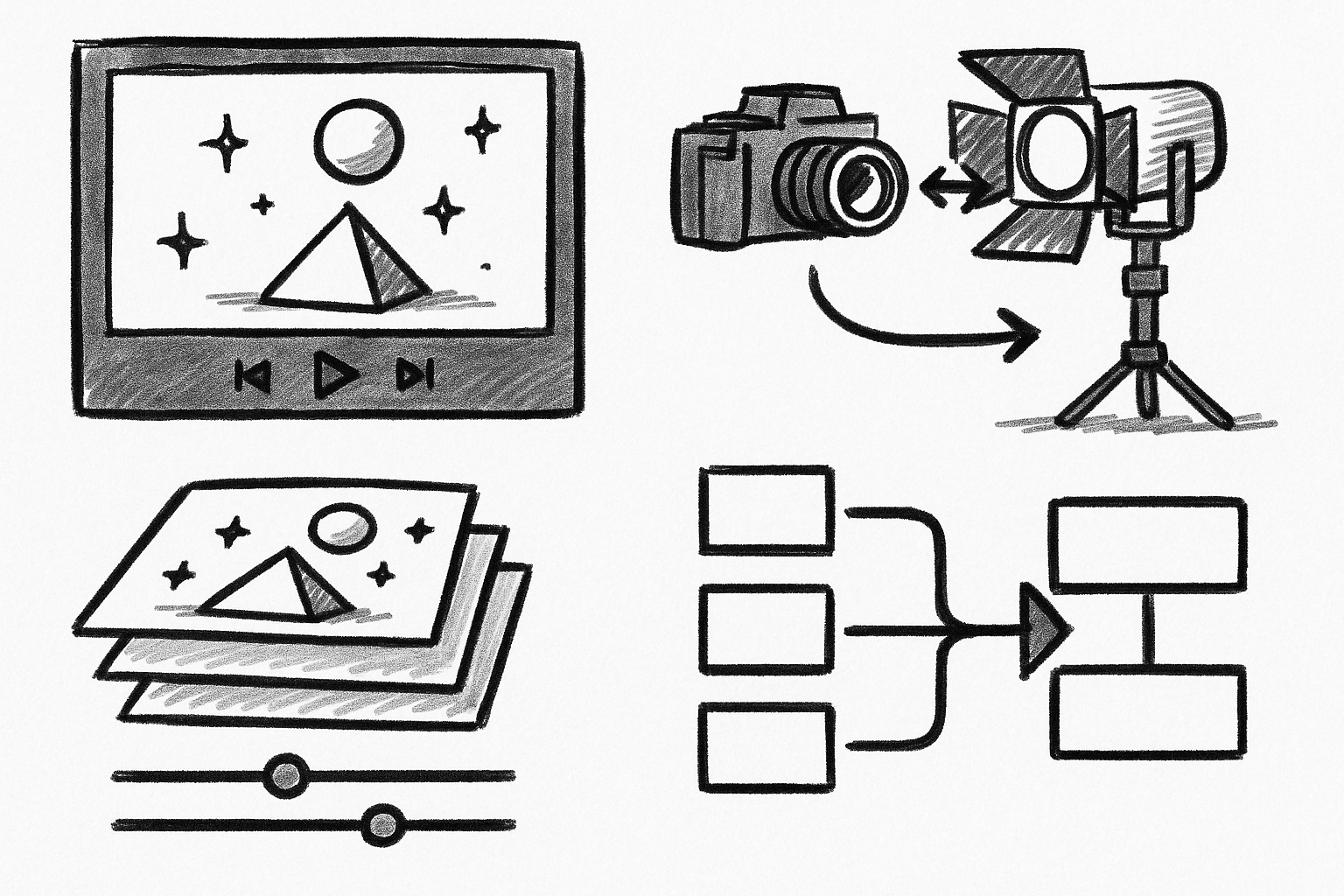Your Cart is Empty
Customer Testimonials
-
"Great customer service. The folks at Novedge were super helpful in navigating a somewhat complicated order including software upgrades and serial numbers in various stages of inactivity. They were friendly and helpful throughout the process.."
Ruben Ruckmark
"Quick & very helpful. We have been using Novedge for years and are very happy with their quick service when we need to make a purchase and excellent support resolving any issues."
Will Woodson
"Scott is the best. He reminds me about subscriptions dates, guides me in the correct direction for updates. He always responds promptly to me. He is literally the reason I continue to work with Novedge and will do so in the future."
Edward Mchugh
"Calvin Lok is “the man”. After my purchase of Sketchup 2021, he called me and provided step-by-step instructions to ease me through difficulties I was having with the setup of my new software."
Mike Borzage
Enterprise Component Libraries: Governance and Collaborative Templates for Scalable Design Reuse
October 26, 2025 11 min read


Why enterprise-scale component libraries need collaborative templates and governance
Business drivers that make templates indispensable
At enterprise scale, the difference between chaotic reuse and strategic reuse is often a well-governed system of collaborative templates that encode intent, quality, and interoperability from the outset. The economic rationale is straightforward: templates accelerate concept-to-release by eliminating reinvention and reducing rework loops. A configurable fastener family, a parameterized bearing seat, or a BIM door assembly with code-aware options can serve thousands of variants while preserving geometric intent and metadata fidelity. This compresses cycle time not only by providing ready-to-use geometry, but by bundling manufacturing guidance, tolerances, and compliance markers into the asset, preventing downstream churn. Just as importantly, templates enforce standardization across MCAD, ECAD, BIM, CAE, and visualization, making cross-domain collaboration predictable and auditable.
Quality and manufacturability improve because template authors can pre-bake acceptable parameter ranges, tolerance budgets, and boundary-condition presets for common simulation scenarios. When a library ensures that GD&T reflects process capability and that mass/inertia envelopes are realistic across the family, suppliers see fewer surprises, and QA sees fewer nonconformances. Compliance also benefits: templates can carry RoHS/REACH flags, lifecycle state, and sustainability indicators such as embodied carbon or recyclability percentages. For visualization and product configurators, multi-LOD representations keep scene graphs light while maintaining authoritative geometry for engineering. The cumulative result is tangible: fewer ECOs tied to avoidable inconsistencies, faster handoffs to manufacturing, and higher first-pass yield for additively manufactured and machined components.
- Reduce design cycle time via parameterized reuse and searchable palettes with relevance ranking.
- Improve quality with embedded MBD, GD&T, and DFMA scoring baked into each template.
- Enable cross-domain consistency by bundling CAD, ECAD, BIM, CAE, and visualization representations.
Failure modes without governance and how they ripple downstream
Absent governance, libraries devolve into a tangle of forks and contradictions. The most common anti-pattern is the proliferation of “golden” parts—nearly identical components with subtle, undocumented edits. Over time, these clones accrue duplicate SKUs, divergent tolerances, and incompatible metadata schemas. Engineering teams unknowingly select different variants for similar functions, which fractures bills of materials and defeats volume leverage. Without standard attribute schema and immutability controls, lineage becomes untraceable: changes propagate into CAD but never reach PLM, ERP, or supplier catalogs, and inspection plans drift from the true design intent.
Another failure mode lies in tolerance and MBD incompatibilities. A thread callout updated in CAD but not reflected in the MBD or supplier drawing can create an inspection mismatch; what passes in incoming QA fails in production because the gaging strategy was tied to an outdated datum scheme. For ECAD/MCAD co-design, ungoverned footprints and symbols cause placement errors and clearance violations, while in BIM, families drift in Level of Development and code compliance, leading to costly construction changes. When CAE meshes and load-case presets are not versioned with geometry, analysts rerun baselines on stale data, undermining trust in simulation. The downstream ripples are real: higher defect leakage, more NCRs, and schedule slip from unplanned rework.
- Forked parts and duplicate SKUs inflate inventory and erode purchasing leverage.
- Incompatible MBD/GD&T yields inspection failures and recurring concessions.
- CAD ⇄ PLM ⇄ ERP drift breaks traceability and complicates regulatory audits.
Scope and stakeholders across the product lifecycle
Effective governance spans far beyond the CAD seat. Design engineers and drafters are primary consumers, yet simulation analysts, manufacturing engineers, quality, procurement, and IT each depend on the integrity of template metadata and behavior. Procurement requires supplier IDs, lead-time classes, and approved manufacturer lists tied to immutable part identifiers. Manufacturing needs process-specific notes, tolerances aligned with capability, and alternate routings for additive versus subtractive builds. Quality wants inspection features, sampling plans, and acceptance criteria co-located with the model. IT and PLM/PDM admins must ensure that permissions, audit trails, and synchronization are enforced across on-prem and cloud repositories.
External stakeholders matter too. Suppliers and contract manufacturers contribute DFM insights and can publish encrypted geometry and printability constraints as overlays. Certifying bodies may provide compliance tags and references for restricted substances or export-control classifications. Toolchain owners—scripting and API maintainers—facilitate generators, set CI/CD gates, and ensure schema validations remain current as standards evolve. The governance framework must enable all these actors to contribute safely: role-based access, review workflows, and controlled promotion from draft to released states make collaboration practical without sacrificing control. When governed correctly, the component library becomes a meeting point for every lifecycle participant, anchoring a resilient digital thread.
- Internal roles: design, CAE, manufacturing, quality, procurement, IT/PLM administrators.
- External roles: suppliers, contract manufacturers, standard bodies, certifying authorities.
- Toolchain owners: PDM/PLM admins, API authors, generator maintainers, data stewards.
Designing collaborative templates that scale
Template taxonomy and granularity
A scalable library begins with a clear taxonomy and the right granularity for templates. It pays to categorize by both function and configurability. Primitive hardware—fasteners, washers, bearings—benefits from parameterized templates that capture standards (ISO, ASME) and constraint logic (diameter threads, head styles, materials). Configurable mechanisms—hinges, dampers, linkages—often need conditionals for kinematic bounds and envelope checks. Material specifications deserve their own template class with properties like stress-strain curves, thermal conductivity, surface finish classes, and sustainability KPIs; in CAE contexts, these tie to material cards across solvers.
For built environment workflows, BIM families must support Level of Development (LOD) variants, code-compliant assemblies, and geographic overlays for regional standards. ECAD requires footprints and symbols synchronized with 3D models, including courtyard, paste/mask layers, and height envelopes for mechanical clearance. Simulation artifacts act as first-class templates too: reusable meshes, boundary-condition presets, canonical load cases, and mesh sizing strategies that travel with geometry families. The guiding principle is to create building blocks that balance reuse and specificity—broad enough to apply across programs, precise enough to enforce intent. By making taxonomy explicit, search and recommendation engines can offer relevant assets quickly, avoiding time-consuming hunts for near matches.
- Hardware and mechanisms: parameterized per standard with guardrails on size/fit.
- BIM families: LOD-defined, code-aware, regionally compliant configurations.
- ECAD assets: synchronized footprints, symbols, 3D bodies, and placement rules.
- CAE templates: solver-ready meshes, boundary presets, material cards, load cases.
Structure and semantics of durable templates
Templates must be not only geometric but semantic. Parametric guardrails keep designs within safe operating envelopes: locked references avoid dangling dimensions; named parameters carry meaning such as “bolt_dia_nominal” or “max_clearance_mm”; and design-intent notes capture why constraints exist. Standardized metadata is the backbone: include Model-Based Definition (MBD), GD&T, lifecycle state, LCA/Sustainability KPIs, compliance tags (RoHS/REACH), and supplier IDs. Critically, record digital thread identifiers—immutable part IDs that link CAD ⇄ PLM ⇄ ERP ⇄ CMMS. Without these, downstream systems drift and analytics lose fidelity.
Multi-representation assets make templates universally consumable. Provide STEP and JT for neutral CAD exchange; IFC for BIM interoperability; 3MF for additive manufacturing; USD or glTF for real-time visualization and web experiences; and low-LOD proxies for configurators and AR. Each representation should be generated from the same source-of-truth geometry through CI to prevent divergence. Include visualization materials and metadata mappings so that product renders remain consistent with engineering changes. Finally, embed unit systems and currency for any economic attributes, and lock critical references (datums, coordinate systems) to avoid accidental reorientation during assembly. These structural choices make templates resilient across tools and time.
- Parametric guardrails: locked references, named parameters, intent annotations.
- Standard metadata: MBD, GD&T, lifecycle, compliance, sustainability KPIs, supplier IDs.
- Multi-representation: STEP/JT, IFC, 3MF, USD/glTF, and proxy LODs for configurators.
- Identifiers: immutable IDs to preserve linkage across enterprise systems.
Design contracts and validation in practice
To keep templates trustworthy, treat their attributes as code and enforce contracts through automation. Use JSON, XML, or YAML schema definitions—versioned and validated in CI—to define required and optional attributes, types, units, and allowed enumerations. This schema-as-code approach prevents silent drift when teams add fields or alter meaning. Pair the schema with acceptance tests: geometric anchors that must exist (datums, pattern seeds), parameter min/max ranges, and tolerance budgets that protect fit and inspection feasibility. Automated checks should lint MBD for completeness, test for clashes and clearances in reference assemblies, confirm mass/inertia envelopes, and compute printability and DFMA scores for manufacturing routes.
Validation should also include reference baselines: quick-run CAE results for canonical parameter sets, stored alongside the template and regenerated on change. These baselines give designers confidence that performance remains within acceptable bounds as they vary configurations. Unit consistency checks are essential—especially when mixing metric and imperial inputs—while metadata mapping tests ensure that PLM attributes and ERP procurement fields synchronize correctly. With these contracts, templates behave like software libraries with unit tests and integration tests, enabling controlled evolution without breaking consuming assemblies or downstream analytics.
- Schema-as-code: JSON/XML/YAML with semantic versioning and CI validation.
- Acceptance tests: geometric anchors, parameter ranges, tolerance budgets.
- Automated checks: MBD lint, clash/clearance, mass/inertia, printability/DFMA.
- Reference baselines: quick-run CAE stored and auto-verified on changes.
Authoring patterns and accessibility
Choosing between “golden templates” and “golden parts” depends on variability and risk. Golden templates are best where controlled configurability is required, while truly fixed items (e.g., purchased modules) can be golden parts with locked geometry and metadata. Scripted generators—via CAD/PLM APIs, notebooks, or DSLs—produce validated variants reproducibly. These generators should output not only geometry but also metadata, multi-representation files, inspection features, and procurement placeholders. Content decomposition further scales authoring: maintain a core template for geometry and parameters, then apply overlays for manufacturing notes (e.g., for casting vs. machining), regional codes, or supplier-specific constraints.
Accessibility determines adoption. Offer in-CAD palettes with search facets (function, size, compliance tags, material class) and relevance ranking driven by usage telemetry. Provide contextual usage guidance, such as recommended mates, torque tables, or kinematic limits, surfaced directly within the design environment. For ECAD, integrate parametric footprints and verified 3D bodies into library panes with placement rules that prevent courtyard violations. For BIM, distribute families with options sets bound to code citations. The best library is the one that finds the user: embed template suggestions in design assistants and PDM check-in dialogs, and enable quick feedback loops for users to propose enhancements.
- Golden templates for configurable families; golden parts for fixed items.
- Scripted generators that emit geometry and synchronized metadata.
- Core template plus overlays for process, region, or supplier constraints.
- In-CAD palettes with search facets, ranking, and embedded usage guidance.
Governance and operating model
Roles and responsibilities
A durable operating model hinges on clearly defined roles. Library Stewards are domain owners who curate taxonomies, approve schemas, and own quality gates for their categories (e.g., fasteners, electrical connectors, BIM envelopes). Maintainers manage the tooling backbone—Git repositories, CI pipelines, artifact registries, and integration glue with PLM. A cross-functional Review Board provides architectural oversight and ensures compliance: they adjudicate breaking changes, harmonize metadata across domains, and align governance with regulatory or export-control requirements. Contributors include internal designers, analysts, manufacturing engineers, and vetted suppliers who propose new templates or enhancements under a formal review workflow.
Responsibilities should be codified. Stewards define acceptance criteria and manage deprecation plans. Maintainers keep generators current, triage CI failures, and maintain mapping to PLM/ERP fields. The Review Board sets policy on semantic versioning and decides when compatibility shims are acceptable. Contributors adhere to contribution guidelines, pass local checks, and provide impact assessments when proposing changes. With explicit accountability and published SLAs (review turnaround times, release cadences), teams know how to engage the library without resorting to ad hoc workarounds.
- Stewards: domain taxonomy, schema ownership, quality gates, deprecations.
- Maintainers: CI/CD, repos, artifact registries, PLM integrations.
- Review Board: architecture, compliance, versioning policy, risk management.
- Contributors: designers, suppliers, analysts operating via defined workflows.
Processes that keep change safe and fast
Governed change management enables agility without chaos. New templates begin as RFCs that articulate scope, taxonomy placement, attribute schema, and intended consumer assemblies. Change requests for existing items must include impact assessments and migration plans. Adopt semantic versioning for both geometry and metadata: MAJOR versions signal breaking interfaces (e.g., datum name changes, parameter removal), MINOR versions add backward-compatible features (e.g., new head styles), and PATCH versions fix defects or metadata typos without altering behavior.
Deprecation policies protect consumers. Publish sunset timelines for older templates, provide auto-migration scripts that remap parameter names and metadata, and, where necessary, supply compatibility shims so assemblies can transition progressively. Maintain a dependency map of assemblies referencing templates; use it for blast-radius analysis during reviews—especially before MAJOR releases. Promotion workflows should progress from Draft to Review to Released to Deprecated, with clear entry/exit criteria and automated checks at each gate. With these processes, the organization can evolve the library rapidly while keeping downstream systems stable.
- RFCs define scope, schema, consumers, and acceptance tests.
- Semantic versioning: MAJOR/MINOR/PATCH for geometry and metadata.
- Deprecations: sunset schedules, auto-migration scripts, compatibility shims.
- Dependency mapping and blast-radius analysis prior to release.
Tooling and automation as the backbone
Automation is the heartbeat of a trusted library. Integrate PLM for status, approvals, and provenance, while using Git to manage scripts, schema, and generators. CI/CD gates execute geometry diffs to highlight shape changes; validate metadata schemas; run DFM/DFMA checks; confirm MBD completeness; ensure BOM integrity; and execute unit tests for generators. Artifact registries act as internal package managers for templates, variants, and multi-representation assets—backed by caching and sync strategies for remote teams. These registries should support content-addressable storage and immutability guarantees for released versions.
Security and IP controls must be first-class. Role-Based Access Control (RBAC) delineates who can view, modify, or export models. Use encrypted models for sensitive supplier interactions; enable selective sharing that reveals only proxy LODs or redacted attributes where necessary. Implement supplier contribution workflows that sandbox submissions, run full validation suites, and require steward approval before promotion. Tag assets with license constraints and export-control classifications to prevent improper distribution. With a robust toolchain, the organization can enforce quality at scale while making contribution smooth and auditable.
- PLM integration for provenance; Git for scripts, schema, and change history.
- CI/CD gates: geometry diffs, schema validation, DFM/DFMA, MBD, BOM checks.
- Artifact registries: internal package management, caching, offline sync.
- RBAC and IP controls: encryption, selective sharing, supplier workflows, export tags.
Measurement and enablement for sustained adoption
What gets measured improves. Track adoption rate (how often templates are used vs. duplicated), duplication rate of functionally equivalent assets, defect leakage tied to template misuse, search success rate, lead time for change approvals, and coverage across top spend categories. Instrument search and selection flows to learn which facets drive success, and use those insights to refine taxonomy and ranking. Monitor deprecation migration progress to spotlight at-risk assemblies. For quality, correlate CI gate failures with root causes to inform training and template refinements.
Enablement multiplies value. Provide playbooks and “docs as code” stored alongside templates, with embedded examples that demonstrate best practices across MCAD, ECAD, BIM, and CAE. Use AR/VR walkthroughs and short, in-CAD tooltips to explain correct mating strategies, datum usage, and inspection plans. Incentivize contributions with recognition in release notes or dashboards, and streamline approvals for teams with a track record of compliant submissions. By combining metrics, education, and incentives, organizations turn governance from a perceived tax into a productivity amplifier.
- KPIs: adoption, duplication, defect leakage, search success, change lead time, spend coverage.
- Training: playbooks, docs-as-code, embedded examples, AR/VR usage guidance.
- Incentives: contributor recognition, fast lanes for compliant teams.
Conclusion
From ad hoc reuse to strategic leverage
A well-governed component library transforms reuse from opportunistic to strategic. By centering on collaborative templates with rich semantics, organizations compress design cycles, reduce errors, and produce consistent downstream outcomes—from manufacturing routings to inspection programs to interactive product visuals. The shift is not merely procedural; it establishes a reliable digital backbone where digital thread identifiers align CAD, PLM, ERP, and maintenance systems, and where multi-representation assets keep every team—from simulation to marketing—in sync. Templates carrying MBD, GD&T, sustainability KPIs, and supplier linkages ensure that what leaves engineering is buildable, compliant, and economically sound.
The leverage compounds as validation is automated and contracts are enforced by CI/CD gates. Schema-as-code prevents semantic drift; acceptance tests and baseline CAE runs safeguard performance as parameters vary; and versioned processes let teams innovate without breaking consumers. The result is fewer ECOs, shorter lead times, and higher confidence across the lifecycle. Instead of firefighting inconsistent parts and reconciling systems post hoc, teams focus on higher-order design and manufacturing innovation—because the library has become an engine of reliability and speed.
- Faster cycles: reusable, validated templates reduce iteration overhead.
- Fewer errors: automated checks and standardized metadata catch issues early.
- Consistency: synchronized representations align all downstream consumers.
Practical first steps and scaling principles
Start small, but start with intent. Target high-churn categories such as fasteners, connectors, or BIM doors/windows that drive frequent rework and outsized supply spend. Establish Steward and Reviewer roles early, and publish contribution guidelines alongside a minimal schema-as-code that captures required attributes and units. Build the first CI gates around what hurts most—MBD completeness, unit consistency, and DFMA checks—then expand into geometry diffs and baseline CAE. Invest early in multi-representation assets (STEP/JT, IFC, 3MF, USD/glTF) and assign immutable IDs to prevent cross-system drift. Expose templates via in-tool palettes with search facets to maximize immediate adoption.
As usage grows, scale with data. Track KPIs, tighten versioning discipline, and phase in deprecation with migration tooling. Introduce scripted generators for high-variability families, and refactor monolithic parts into core templates plus overlays for manufacturing or regional constraints. Evolve governance by adding a Review Board drawn from design, manufacturing, quality, and IT to arbitrate breaking changes and ensure compliance. Treat templates as living products: prioritize a backlog, ship on a cadence, automate quality gates, and encourage safe contributions through recognition and fast-lane approvals. With these practices, the library becomes a compounding asset—one that turns reuse into a durable competitive advantage.
- Start where churn and spend are highest; publish minimal viable schema and gates.
- Adopt immutable IDs and multi-representation assets from day one.
- Iterate via metrics; automate checks; scale contribution with clear contracts.
Also in Design News

Cineware Best Practices: Live In-Comp Rendering, Camera/Light Sync, AOVs & Take-Based Versioning
October 26, 2025 11 min read
Read MoreSubscribe
Sign up to get the latest on sales, new releases and more …




